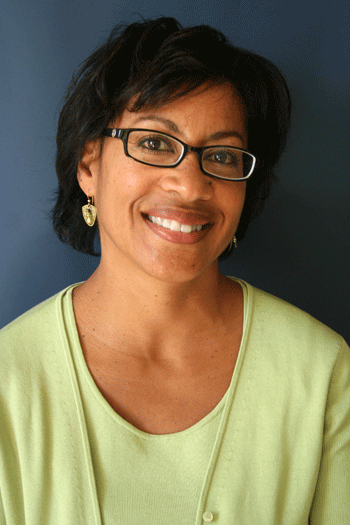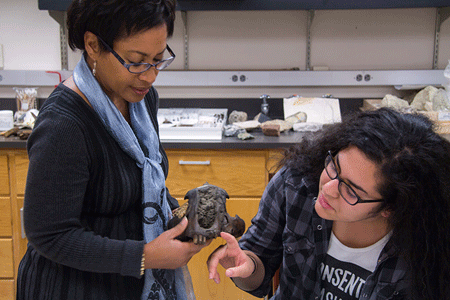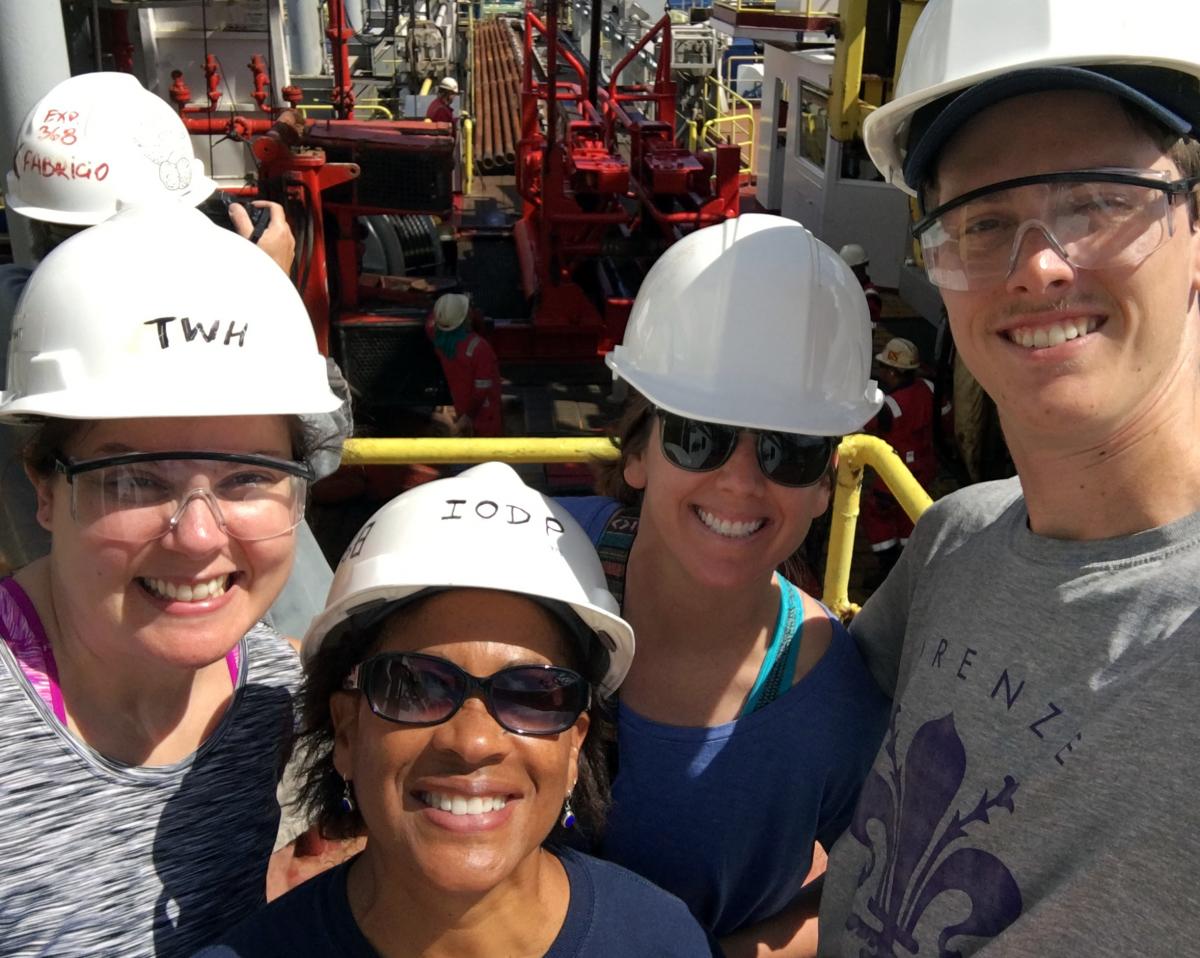Lisa White: Redefining a “Rockstar Scientist”
August 2017
For this month’s spotlight, we’re introducing a community member that we admire for their commitment science education. We spotlight UCMP Director of Education and Outreach Lisa White. As an African-American Woman in STEM, Lisa has overcome barriers in the geology field and now helps breakdown the stereotypes of what it means to be a scientist. We love Lisa’s passion for science outreach and are thrilled to have her on our Advisory Council!
 Lisa White didn’t always know that she wanted to study science. Born and raised in San Francisco near Golden Gate Park, Lisa grew up with a love for landscape photography and intended to study photography at San Francisco State. When she was in college, Lisa took a geology class and became interested in how landscapes are formed. From that point on, Lisa was hooked. She interned at the US Geological Survey (USGS) where she became fascinated by earthquake monitoring and the study of other geological hazards like the eruption of Mount St. Helens. When she got back to school, Lisa changed her major to geology and had the opportunity to do field work with the USGS in places like Denali National Park and the Mendenhall Glacier in Alaska. She eventually migrated to paleontology thanks to some great women mentors at the USGS.
Lisa White didn’t always know that she wanted to study science. Born and raised in San Francisco near Golden Gate Park, Lisa grew up with a love for landscape photography and intended to study photography at San Francisco State. When she was in college, Lisa took a geology class and became interested in how landscapes are formed. From that point on, Lisa was hooked. She interned at the US Geological Survey (USGS) where she became fascinated by earthquake monitoring and the study of other geological hazards like the eruption of Mount St. Helens. When she got back to school, Lisa changed her major to geology and had the opportunity to do field work with the USGS in places like Denali National Park and the Mendenhall Glacier in Alaska. She eventually migrated to paleontology thanks to some great women mentors at the USGS. Some of Lisa’s mentors include professors David Mustart and Raymond Sullivan from San Francisco State University. While she valued their mentorship, she notes that the geology field is mainly dominated by white males. Lisa says, “there are lots of strong stereotypes to battle as a woman of color,” and that she often felt “classic feelings of isolation and imposter syndrome” as she worked to advance in the discipline. When I was an undergraduate student, most of the people in the geology field were “burly guys with a background in hiking and the outdoors,” and “all images of geologists supported these stereotypes.”
Some of Lisa’s mentors include professors David Mustart and Raymond Sullivan from San Francisco State University. While she valued their mentorship, she notes that the geology field is mainly dominated by white males. Lisa says, “there are lots of strong stereotypes to battle as a woman of color,” and that she often felt “classic feelings of isolation and imposter syndrome” as she worked to advance in the discipline. When I was an undergraduate student, most of the people in the geology field were “burly guys with a background in hiking and the outdoors,” and “all images of geologists supported these stereotypes.” Lisa continued to build her passion for science outreach as a faculty member at SF State. In addition to teaching classes and doing research, Lisa worked with the Committee on the Public Understanding of Science (COPUS) and the NSF-funded Minority Education through Traveling and Learning in the Sciences (METALS) among other science outreach programs. She has used these platforms as a “way to invest in the next generation.” Lisa is motivated to reach others because she is thankful for those that were “fundamental in her own development” and wants to be that for future scientists.
Lisa continued to build her passion for science outreach as a faculty member at SF State. In addition to teaching classes and doing research, Lisa worked with the Committee on the Public Understanding of Science (COPUS) and the NSF-funded Minority Education through Traveling and Learning in the Sciences (METALS) among other science outreach programs. She has used these platforms as a “way to invest in the next generation.” Lisa is motivated to reach others because she is thankful for those that were “fundamental in her own development” and wants to be that for future scientists. This summer, Lisa co-led a trip appropriately named the “School of Rock,” where 10 high school teachers and 10 faculty members travel from the Philippines to Australia together on JOIDES Resolution, a research vessel that drills into the ocean floor to collect and study sedimentary core samples. This trip serves the dual purpose of collecting scientific data as well as exposing teachers to the scientific process so they can pass it along to their students. Lisa is passionate about investing in the next generation of scientists as she believes that her teachers were “key to successfully navigating a path to science.” The trip is a memorable one for scientists and educators alike, incorporating fun traditions when the vessel passes the equator .
This summer, Lisa co-led a trip appropriately named the “School of Rock,” where 10 high school teachers and 10 faculty members travel from the Philippines to Australia together on JOIDES Resolution, a research vessel that drills into the ocean floor to collect and study sedimentary core samples. This trip serves the dual purpose of collecting scientific data as well as exposing teachers to the scientific process so they can pass it along to their students. Lisa is passionate about investing in the next generation of scientists as she believes that her teachers were “key to successfully navigating a path to science.” The trip is a memorable one for scientists and educators alike, incorporating fun traditions when the vessel passes the equator . From her feature on the PBS special “Making North America” to a spot on Bill Nye the Science Guy, Lisa has used her platform to share science with others on television. In her “Making North America” feature, Lisa collaborated with NOVA and Smithsonian National Museum of Natural History Director Kirk Johnson to explore the San Andreas Fault, taking viewers to Tomales Bay and the Bug Creek Mine in California. With Bill Nye, Lisa was in the “Way Cool Scientist” segment, sharing the research in her lab. While she “doesn’t’ always like being on camera,” Lisa cherishes the opportunity to break down barriers as an African-American Woman in STEM and share sound science with others. She notes that it’s “important for young students to see science role models that look like them” and that television is a great place to gain that exposure.
From her feature on the PBS special “Making North America” to a spot on Bill Nye the Science Guy, Lisa has used her platform to share science with others on television. In her “Making North America” feature, Lisa collaborated with NOVA and Smithsonian National Museum of Natural History Director Kirk Johnson to explore the San Andreas Fault, taking viewers to Tomales Bay and the Bug Creek Mine in California. With Bill Nye, Lisa was in the “Way Cool Scientist” segment, sharing the research in her lab. While she “doesn’t’ always like being on camera,” Lisa cherishes the opportunity to break down barriers as an African-American Woman in STEM and share sound science with others. She notes that it’s “important for young students to see science role models that look like them” and that television is a great place to gain that exposure.